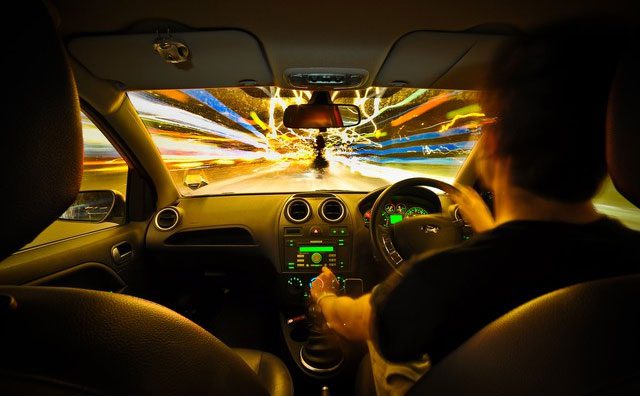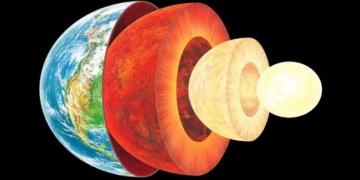The speed of light is the fastest speed known to date.
The laws of physics tell us that the speed of any object with rest mass in the universe can only approach but never reach or exceed the speed of light.
This is because as the speed of an object gets closer to the speed of light, its mass increases and requires more energy, ultimately reaching infinity. This is the relativistic mass-energy equation, which tells us that mass and energy are equivalent, and the speed of light is the conversion factor between them.

The speed of all objects in the universe only approaches the speed of light. (Illustrative image).
Therefore, for an object to reach the speed of light, it would require infinite energy, which is impossible. But what would happen if we assume that humans could move faster than the speed of light? This is a fascinating and controversial topic, with scientists and science fiction writers offering various hypotheses and assumptions about it.
The universe is vast and mysterious, containing tens of thousands of galaxies, each holding billions of stars and planets, some of which may harbor life. Given the small probability events, with the support of the vast number of humans in the universe, it is very likely that there are civilizations more advanced than humanity’s, which may have mastered faster-than-light technology and can freely travel and explore the universe. They may have discovered the existence of humans but for some reason are unable to communicate with us.
If humans could exceed the speed of light, we would be able to travel between stars and communicate with higher extraterrestrial civilizations, thereby gaining unprecedented knowledge, technology, and intelligence that would allow human civilization to develop and improve further. Of course, this is also a double-edged sword, as we cannot predict the intentions or attitudes of extraterrestrial civilizations; they may be friendly or hostile.

When humans exceed the speed of light, light will shift from virtual to real. (Illustrative image).
If we could encounter friendly advanced civilizations, humanity could further develop and learn from their technology and culture. We could establish friendly relationships with them and explore the mysteries of the universe together, which would be the greatest leap in human history.
<pHowever, if we encounter a hostile advanced civilization, humanity could face annihilation, being regarded as inferior, enslaved, or even eradicated. The universe also operates on the law of the jungle, where survival belongs to the strongest; advanced civilizations could invade, loot, or experiment on lower civilizations.
This would be the worst nightmare in human history. Therefore, if we wish to exceed the speed of light, we must adequately prepare to enhance not only our technological proficiency but also our moral standards.
When humans exceed the speed of light, light will shift from virtual to real. The light around us will gradually change from images that are virtual to physical images, consisting of events we have experienced in the past.
This is because light is electromagnetic waves and requires a certain amount of time to propagate through space. When we see stars in the sky, we see them as they were in the past, because the light they emit takes millions or even billions of years to reach our eyes.

Even if the speed exceeds that of light, we cannot change the past. (Illustrative image).
Similarly, when we observe objects around us, we see them as they were in the past, but the time period is so short that it can be overlooked. However, when our speed exceeds that of light, we will catch up to and even surpass the speed of light, allowing us to witness the history of light, which is our history. We become like viewers of a time film, quietly following our past on an “screen.”
This sounds intriguing and captivating, as we might encounter some people and events we have forgotten or missed, possibly our childhood, our loved ones, or our regrets. We may find a bit of happiness, a touch of emotion, and a glimpse of enlightenment from it. But we cannot change the past.
The past is the past, and no matter how hard we try, we cannot alter the course of events. The order of time and space in the universe does not allow anyone to arbitrarily disrupt the past or the future; the past has become history and is recorded by time and space.
If we attempt to change the past, we may trigger certain paradoxes, such as the grandfather paradox. This leads to an endless loop and self-contradiction. Therefore, attempting to change the past or look into the future through time travel is unrealistic.
The space we inhabit today is three-dimensional; we can perceive length, width, and height, which form our spatial coordinate system. However, we cannot perceive time; to us, time flows in one direction—we can only move from the past to the future and cannot reverse or stop it.
However, physicists believe that time is indeed the fourth dimension of space, forming four-dimensional spacetime, and we simply cannot observe it directly due to our limited perception capabilities.

Currently, there are no experiments that can prove that humans can exceed the speed of light. (Illustrative image).
If humans could exceed the speed of light, they would likely enter four-dimensional spacetime, where humans would not be bound by time; this would be a completely new realm for humanity, allowing us to freely choose where we want to go, whether it be a moment in the past, a moment in the future, or a parallel moment. We could explore different timelines at will, see various possibilities, and experience different lives.
Time would no longer be as important to humans; we could swim in the long river of time and enjoy the beauty of time. We could also choose between various temporal forks and create the wonders of time. Simultaneously, humanity could attain a mythic level, as we could control time, even create time, becoming the masters of time and creators of time.
Of course, these outcomes are based on several theories and assumptions; currently, there are no experiments or evidence to prove that humans can exceed the speed of light or that these events would occur after surpassing the speed of light.
All of this is our imagination and speculation, and perhaps one day we will experiment with these ideas, or perhaps never. However, this does not prevent us from exploring and contemplating this subject, as it embodies human curiosity and creativity, while also serving as a driving force for human progress and development.


















































